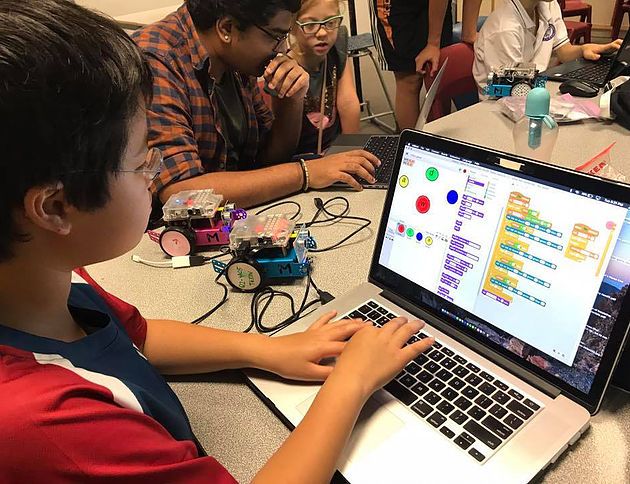
Coding Camps Explode Globally
In an era defined by rapid technological advancement, the ability to code has transcended a niche skill to become a foundational literacy for the 21st century. As industries across the globe undergo digital transformation, the demand for proficient software developers, data scientists, and cybersecurity experts continues to skyrocket, far outstripping the supply from traditional university programs. This burgeoning skills gap has paved the way for an unprecedented phenomenon: the global explosion of coding camps. These intensive, immersive bootcamps offer an accelerated pathway into tech careers, transforming novices into job-ready professionals in a matter of weeks or months. For individuals eager to pivot into high-demand fields and for content platforms aiming for high Google AdSense revenue through highly relevant and sought-after information, understanding this global trend is crucial. This comprehensive article will delve deep into why coding camps are experiencing such exponential growth, explore their diverse models and curriculum, assess their effectiveness, and shed light on their pivotal role in shaping the future workforce.
The Rise of Coding Camps: A Global Phenomenon
The meteoric rise of coding camps is a direct response to a critical imbalance in the global job market. Traditional four-year university computer science degrees, while offering deep theoretical knowledge, often struggle to keep pace with the swift evolution of industry demands and the practical, hands-on skills required by employers. Coding camps, or “bootcamps,” emerged as agile, industry-driven alternatives, promising to bridge this gap with concentrated, practical training. Their growth has been truly global, mirroring the widespread digitalization of economies.
Several factors fuel this explosive growth:
- Massive Tech Skills Gap: The demand for tech talent consistently outpaces supply in virtually every major economy. Companies across sectors—from finance to healthcare to entertainment—now rely heavily on software, data, and digital infrastructure.
- Accessibility and Speed: Coding camps offer a much faster and often more affordable route into tech compared to traditional university degrees. Many programs range from 10 to 24 weeks, allowing individuals to quickly reskill or upskill.
- Career Transformation Potential: These bootcamps appeal to career changers, recent graduates looking for practical skills, and even seasoned professionals seeking to stay relevant. They offer a tangible path to higher salaries and exciting career prospects.
- Industry-Driven Curriculum: Unlike academic institutions, coding camps are highly responsive to industry needs. Their curricula are constantly updated to teach the most in-demand programming languages, frameworks, and tools.
- Focus on Employability: A primary goal of most coding camps is job placement. They often include career services, interview preparation, and networking opportunities, making them highly attractive to job seekers.
- Globalization of Tech Jobs: Remote work has blurred geographical boundaries, enabling individuals trained in coding camps anywhere in the world to access global job markets, further fueling demand for accessible training.
The phenomenon is not confined to tech hubs; coding camps are flourishing in developing nations as well, offering unprecedented opportunities for economic advancement and digital inclusion.
Diverse Models of Coding Camp Education
The coding camp landscape is remarkably diverse, offering various structures and specializations to cater to different learning styles, schedules, and career aspirations. Understanding these models is key to choosing the right program.
A. Full-Time Immersive Bootcamps
These are the quintessential coding camp experience. They are highly intensive and typically run for 10-16 weeks, often requiring participants to commit 40+ hours per week to learning.
- Structure: Daily lectures, pair programming, individual projects, and group assignments. The focus is on hands-on coding.
- Curriculum: Deep dive into one or two specific tech stacks (e.g., Full-Stack Web Development, Data Science, Cybersecurity).
- Benefits: Rapid skill acquisition, strong peer network, immediate career focus.
- Considerations: Requires significant time commitment, often means pausing employment, can be mentally demanding.
B. Part-Time Programs
Designed for individuals who need to balance their learning with existing work or family commitments.
- Structure: Classes held evenings or weekends, stretching the curriculum over 24-48 weeks.
- Curriculum: Similar to full-time programs but paced more slowly.
- Benefits: Flexibility, ability to maintain income, less intense daily schedule.
- Considerations: Slower progression, requires strong self-discipline to stay motivated over a longer period.
C. Online Bootcamps
These programs offer maximum flexibility, allowing students to learn from anywhere in the world, often at their own pace.
- Structure: Can be self-paced, instructor-led with live virtual classes, or a hybrid model. Communication often happens via dedicated online platforms, Slack, and video conferencing.
- Curriculum: Covers a wide range of tech specializations, just like in-person camps.
- Benefits: Geographical flexibility, often lower cost (no relocation needed), caters to diverse time zones.
- Considerations: Requires strong self-motivation, can lack the immediate peer interaction of in-person classes, prone to distractions.
D. Hybrid Models
Combining elements of online and in-person learning, these offer a blend of flexibility and structured support.
- Structure: May involve initial in-person onboarding, regular in-person workshops, or dedicated co-working spaces combined with online lectures and project work.
- Curriculum: Varies based on the specific program’s design.
- Benefits: Blends the best of both worlds, offering flexibility with physical community support.
- Considerations: Depends heavily on the quality of the hybrid integration; may still require some travel.
E. Corporate Training/Reskilling Programs
Many companies are now partnering with or developing their own internal coding bootcamps to reskill existing employees or onboard new talent quickly.
- Structure: Tailored to specific company needs, often full-time and in-house.
- Curriculum: Highly specialized, focusing on technologies relevant to the company’s operations.
- Benefits: Guaranteed job placement (often), company-specific skill development, no tuition cost for employees.
- Considerations: Limited to employees of participating companies, may involve commitment clauses.
Key Curricula and Specializations Offered
The explosion of coding camps has led to a diversification of curricula, moving beyond just web development to encompass a broader spectrum of high-demand tech skills.
A. Full-Stack Web Development
This is perhaps the most popular offering, aiming to train developers who can work on both the front-end (what users see) and back-end (server, database) of web applications.
- Front-End Technologies: HTML, CSS, JavaScript, React, Angular, Vue.js.
- Back-End Technologies: Node.js, Python (Django/Flask), Ruby on Rails, Java (Spring Boot), PHP (Laravel).
- Databases: SQL (PostgreSQL, MySQL), NoSQL (MongoDB).
- Version Control: Git/GitHub.
B. Data Science and Analytics
Addressing the explosion of data, these programs train individuals to collect, clean, analyze, and interpret large datasets to extract insights.
- Programming Languages: Python (with libraries like Pandas, NumPy, Scikit-learn), R.
- Tools: SQL, Jupyter Notebooks, data visualization tools (Matplotlib, Seaborn, Tableau, Power BI).
- Concepts: Statistics, machine learning fundamentals, data cleaning, data visualization, predictive modeling.
C. Cybersecurity
Responding to the escalating threat landscape, cybersecurity bootcamps equip students with defensive and offensive security skills.
- Foundations: Networking, operating systems (Linux), cryptography.
- Offensive Security: Ethical hacking, penetration testing, vulnerability assessment.
- Defensive Security: Security operations (SecOps), incident response, threat intelligence, security architecture.
- Compliance: Understanding regulatory frameworks (e.g., GDPR, HIPAA).
D. UX/UI Design
Focusing on the user experience (UX) and user interface (UI) of digital products, these camps blend design principles with tech understanding.
- UX Research: User interviews, usability testing, persona creation.
- UI Design: Wireframing, prototyping, visual design, design systems (e.g., Figma, Sketch, Adobe XD).
- Front-End Basics: Sometimes include introductory HTML/CSS to understand developer handoff.
E. Mobile App Development
Specializing in creating applications for iOS or Android platforms.
- iOS Development: Swift, Xcode.
- Android Development: Kotlin/Java, Android Studio.
- Cross-Platform: React Native, Flutter.
F. DevOps and Cloud Engineering
Training in the practices and tools that integrate software development (Dev) and IT operations (Ops), often leveraging cloud platforms.
- Cloud Platforms: AWS, Azure, Google Cloud.
- Containerization: Docker, Kubernetes.
- Automation Tools: Ansible, Terraform, Jenkins.
- Scripting: Bash, Python.
The Effectiveness of Coding Camps: Outcomes and Criticisms

The rapid expansion of coding camps naturally raises questions about their effectiveness compared to traditional education. While success metrics vary, and some criticisms exist, the overall impact is largely positive.
A. Employment Outcomes
- High Placement Rates: Many reputable bootcamps boast job placement rates ranging from 70% to 90% within six months of graduation. This is a key selling point.
- Increased Salaries: Graduates often see a significant increase in their earning potential compared to their previous careers, making the tuition investment worthwhile.
- Diverse Roles: Graduates secure roles as junior developers, data analysts, QA engineers, UX designers, and more.
- Employer Recognition: Initially skeptical, many tech companies now actively recruit from coding camps, recognizing the practical skills and problem-solving abilities of their graduates.
B. Key Criticisms
- High Tuition Costs: While faster than a degree, bootcamps can still be expensive (ranging from $5,000 to $20,000+), though income share agreements (ISAs) or deferred payment options exist.
- Lack of Theoretical Depth: Critics argue that the accelerated pace sacrifices the deep theoretical computer science knowledge gained in a university setting.
- Intense Pace and Burnout: The immersive nature can be overwhelming, leading to high stress levels and potential burnout if students aren’t prepared for the intensity.
- Quality Variation: The industry is largely unregulated, meaning the quality and effectiveness of programs can vary significantly. Due diligence is crucial for prospective students.
- Entry-Level Roles: While leading to employment, graduates typically start in junior roles, requiring continued learning and growth.
Despite these criticisms, for many, the pragmatic, career-focused approach of coding camps represents a highly efficient and effective pathway to a new career in tech.
The Role of Coding Camps in the Future Workforce
As the global economy continues its inexorable shift towards digitalization, coding camps are poised to play an even more critical role in shaping the workforce of tomorrow. They are not merely an alternative to traditional education but a vital, agile component of a diversified learning ecosystem.
A. Democratizing Tech Education
- Lowering Barriers: Coding camps make tech education more accessible to individuals from diverse backgrounds, including those without traditional STEM degrees, women, minorities, and older adults seeking career changes.
- Addressing Socioeconomic Disparities: Many bootcamps offer scholarships or income-share agreements, allowing individuals from lower socioeconomic backgrounds to access high-paying tech jobs, fostering greater equity.
- Global Reach: Online and hybrid models enable individuals in regions with limited educational infrastructure to access high-quality tech training.
B. Fostering Lifelong Learning
- Continuous Upskilling: The tech industry evolves rapidly. Coding camps instill a mindset of continuous learning and adaptation, essential for long-term career success.
- Specialized Reskilling: As new technologies emerge (e.g., AI, quantum computing), coding camps can quickly develop specialized programs to reskill workers, preventing obsolescence.
- Micro-Credentialing: The modular nature of bootcamp education aligns with the growing trend of micro-credentialing, where specific skills are certified, rather than broad degrees.
C. Driving Innovation and Industry Adaptability
- Feedback Loop with Industry: Coding camps maintain close ties with employers, ensuring their curriculum remains highly relevant and responsive to the latest industry demands and emerging technologies.
- Diverse Talent Pool: By bringing individuals from various backgrounds into tech, coding camps foster diversity of thought, which is a powerful driver of innovation.
- Agile Workforce Development: They provide a mechanism for industries to quickly develop the specific skill sets needed to adopt new technologies and business models.
D. Complementing Traditional Education
Rather than competing, coding camps and universities are increasingly seen as complementary.
- University Partnerships: Some universities are integrating coding camp-style bootcamps into their extended education programs.
- Pre-Bootcamp Preparation: Traditional computer science graduates sometimes attend bootcamps to gain practical, job-ready skills that complement their theoretical knowledge.
- Pathways to Higher Education: Some bootcamps offer pathways or credit towards master’s degrees in tech fields.
The symbiotic relationship between these educational models is crucial for building a robust, adaptable, and innovative global tech workforce capable of tackling the challenges and opportunities of the digital age.
Challenges and Considerations for the Future

While the outlook for coding camps is overwhelmingly positive, several challenges and considerations need to be addressed to ensure their continued growth and effectiveness.
A. Quality Control and Accreditation
- Standardization: As the industry matures, there’s a growing need for greater standardization and transparent reporting of outcomes (e.g., graduation rates, job placement rates, average salaries).
- Accreditation: While most bootcamps are not traditionally accredited, the discussion around quality assurance and consumer protection is ongoing. Third-party evaluations or industry certifications could become more prevalent.
- Transparency: Prospective students need clear, verifiable data on program outcomes to make informed decisions.
B. Funding and Affordability
- Tuition Barriers: Despite being faster, tuition costs remain substantial for many, potentially excluding lower-income individuals without strong financing options.
- Income Share Agreements (ISAs): While innovative, ISAs (where tuition is paid back as a percentage of future income) require careful consideration of terms and conditions.
- Government Support: Greater government investment in tech reskilling programs and subsidies for low-income students could further democratize access.
C. Staying Relevant in a Rapidly Changing Landscape
- Curriculum Agility: Bootcamps must continuously update their curricula to remain relevant as new technologies and programming languages emerge. This requires constant industry engagement.
- Beyond the Basics: As the entry-level market becomes more saturated, bootcamps may need to offer more advanced or specialized tracks to ensure graduates stand out.
- AI’s Impact: The rise of AI tools (like GitHub Copilot) will change how developers work, requiring bootcamps to adapt their teaching methodologies and focus on skills that complement AI, such as complex problem-solving, architectural design, and critical thinking.
D. Mental Health and Support
- Student Well-being: The intense nature of bootcamps can lead to stress, anxiety, and burnout. Providing adequate mental health support and fostering a supportive learning environment is crucial.
- Post-Graduation Support: Continued mentorship and community support post-graduation can aid in job search and early career development.
Addressing these challenges head-on will be essential for coding camps to solidify their position as a cornerstone of global workforce development and ensure they continue to deliver on their promise of rapid career transformation.
The New Frontier of Tech Education
The global explosion of coding camps is more than just a passing trend; it represents a fundamental recalibration of how we acquire and value essential technological skills. Driven by an insatiable global demand for tech talent and the inherent agility of their educational model, these intensive bootcamps are rapidly democratizing access to high-paying careers, fostering a culture of continuous learning, and providing industries with the vital, job-ready professionals they desperately need. From full-stack web development to cutting-edge data science and cybersecurity, coding camps offer concentrated, practical training that complements, and in many cases, accelerates pathways into the digital economy.
While challenges remain regarding standardization, affordability, and the ever-present need for curriculum agility in a fast-evolving tech landscape, the strategic importance of coding camps cannot be overstated. They are empowering career changers, upskilling existing workforces, and directly addressing critical skills gaps that traditional educational institutions often struggle to fill at the required pace. As technology continues its relentless march forward, these immersive programs will undoubtedly remain at the forefront of preparing a robust, adaptable, and innovative global workforce. For individuals seeking a rapid entry or pivot into the burgeoning tech sector, coding camps offer a potent and proven solution, solidifying their status as a pivotal force in the future of education and employment, and a topic of immense interest for maximizing online engagement and Google AdSense revenue.
